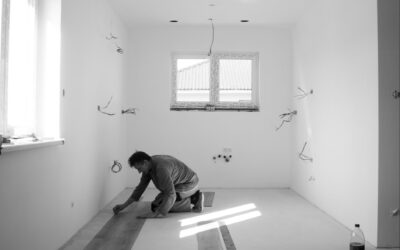Luxury Vinyl Tile Flooring or LVT flooring for short is incredibly popular due to its easy installation, incredible durability, and superb range of colors and designs. A question we often get, however, is does LVT flooring need underlay.
This is a reasonable question as with many flooring types, underlay is typically needed to add additional protection, cushioning, and soundproofing. In this guide, we dissect LVT flooring and explain when underlay may or may not be required.
Brief Overview of Luxury Vinyl Tile Flooring
Let’s start with an intro to LVT flooring so you can see the benefits compared to other flooring types. Luxury vinyl tile flooring is meant to emulate traditional wood or stone floors but is made from multiple layers of PVC vinyl.
The construction process includes compression, rolling, and drying, and manufacturers often add embossing to the top layer to give the tiles additional realism and depth. LVT flooring offers numerous benefits including:
- Easy to install
- Affordable compared to other flooring options
- Durable and long-lasting
- Better soundproofing than wood and stone
- A huge array of designs, styles, and colours
- Relatively easy to replace damaged tiles
If you want to add a little style and sophistication to your home without spending a fortune on ceramic tiles or stone floors, LVT flooring is the best alternative. Just check out our superb range of LVT flooring and you will see the potential for creativity it affords.
Underlay Requirements for the Different Types of LVT Flooring
Do you need an underlay for LVT? This depends entirely on the LVT flooring type and manufacturer and we can split this into two main categories – LVT glue-down flooring, and LVT click flooring.
LVT Glue-Down Flooring
LVT glue-down flooring is a type of LVT flooring where the tiles are glued to the subfloor. With this installation method, a strong bond is created between the tiles and the subfloor and this prevents any movement and distortion of the LVT flooring.
If you added a layer of underlay between the LVT glue-down flooring and the subfloor, this would break that connection. As a result, there could be movement in the floor tiles which is undesirable. Therefore, underlay is not recommended or required with LVT glue-down flooring.
LVT Click Flooring
Luxury Vinyl Tile Click Flooring is essentially a type of LVT flooring that locks together like a jigsaw. With this installation method, the flooring isn’t glued to the subfloor and creates a “floating floor” that is locked in place. A few mm is allowed for expansion and contraction due to temperature changes but for all intents and purposes, you simply slot the tiles into place over the subfloor.
Depending on the manufacturer and design of the LVT click flooring, underlay can be required. Most LVT click flooring products include an additional layer of underlay beneath the vinyl tile, therefore, with these, underlay is not required.
However, if the LVT click flooring does not have that additional layer, it is a great idea to install underlayment first.
Benefits of Using Underlay With LVT Flooring
So, we’ve established that underlayment can be required for some LVT click flooring but NOT for LVT glue-down flooring. When used with LVT click flooring, underlay can offer the following benefits:
Comfort
Generally, LVT flooring is relatively comfortable to walk on and it does have a level of built-in cushioning. Indeed, LVT glue-down flooring with underlay is much more comfortable to walk on than ceramic tiles, wood flooring, or stone flooring.
However, LVT click flooring without built-in underlay can feel a little hard on your feet as it’s installed directly on top of the subfloor with minimum cushioning. Adding a layer of underlay in this instance will improve the comfort and make the tiles much more pleasant to walk on.
Soundproofing
While LVT flooring does have an element of cushioning and is more soundproofed than ceramic tiles, wooden, or stone floors, there still can be an echo and they are not as soundproofed as carpets, for example.
A layer of underlayment gives additional soundproofing and can make the LVT click flooring more pleasing to walk on without creating a huge amount of noise.
Protection
As mentioned above, some LVT click flooring does not have a layer of built-in underlay. This means that the tiles would be installed directly onto the subfloor with no cushioning. Adding an underlay in between adds a vital layer of protection and can improve the durability of the LVT click flooring.
Underlay for LVT Flooring is Not Necessary But Can Help
I hope you have a clear understanding of the need for LVT flooring underlay and how it can be beneficial. Essentially, underlay is not required for glue-down LVT flooring, but it can be beneficial regardless. In contrast, underlay should be considered for LVT click flooring and indeed some manufacturers advise it as part of the installation.









